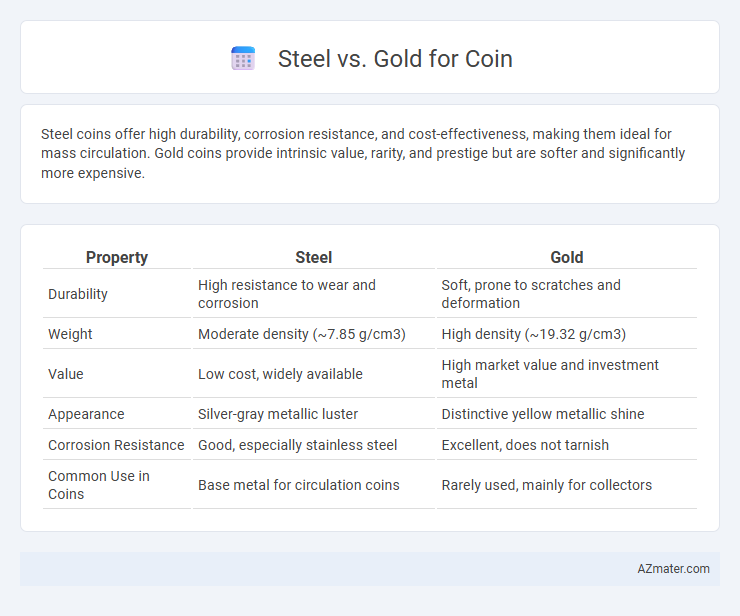Steel coins offer high durability, corrosion resistance, and cost-effectiveness, making them ideal for mass circulation. Gold coins provide intrinsic value, rarity, and prestige but are softer and significantly more expensive.
Table of Comparison
| Property | Steel | Gold |
|---|---|---|
| Durability | High resistance to wear and corrosion | Soft, prone to scratches and deformation |
| Weight | Moderate density (~7.85 g/cm3) | High density (~19.32 g/cm3) |
| Value | Low cost, widely available | High market value and investment metal |
| Appearance | Silver-gray metallic luster | Distinctive yellow metallic shine |
| Corrosion Resistance | Good, especially stainless steel | Excellent, does not tarnish |
| Common Use in Coins | Base metal for circulation coins | Rarely used, mainly for collectors |
Introduction: Comparing Steel and Gold Coins
Steel and gold coins differ significantly in composition, value, and durability, with steel offering affordability and corrosion resistance, while gold provides intrinsic worth and long-term investment potential. Steel coins are commonly used in circulation due to their lower cost and resistance to wear, whereas gold coins are prized for rarity and historical significance. Understanding these contrasts helps collectors and investors choose between practical usage and asset preservation in numismatics.
Historical Use of Steel and Gold in Coinage
Steel and gold have played distinct roles in coinage throughout history, with gold prized for its intrinsic value and durability, often used in high-denomination coins and commemorative pieces since ancient civilizations like Egypt and Rome. Steel emerged as a practical alternative during periods of economic hardship and war, notably in the 20th century, offering durability and cost-efficiency for low-value circulating coins in countries such as the United States and the United Kingdom. The contrast between gold's rarity and cultural prestige versus steel's accessibility and resilience highlights the evolving economic and material priorities influencing coin production over centuries.
Physical Properties of Steel vs Gold
Steel exhibits high tensile strength, durability, and corrosion resistance, making it ideal for coins that require longevity and resistance to wear. Gold, with its superior malleability, density of 19.32 g/cm3, and resistance to tarnish, provides a visually appealing and valuable coin, but is softer and more prone to surface scratches. The contrasting hardness and density of steel (approximately 7.8 g/cm3) and gold influence coin weight, durability, and visual characteristics essential in coin minting.
Durability and Longevity of Steel and Gold Coins
Steel coins offer exceptional durability due to their resistance to scratches, corrosion, and wear, making them ideal for long-term circulation. Gold coins, while softer and more prone to scratches, excel in longevity since gold is chemically inert and does not tarnish or corrode over time. The choice between steel and gold for coins balances steel's physical resilience with gold's unmatched chemical stability and lasting value.
Aesthetic Appeal: Appearance and Finish
Gold coins exhibit a rich, lustrous yellow hue that naturally attracts collectors and investors due to their timeless, luxurious appearance. Steel coins, by contrast, offer a more industrial, matte finish that can be enhanced with plating or polishing but generally lacks the warm glow of precious metals. The superior reflectivity and long-lasting shine of gold make it the preferred choice for high-end, collectible coins where aesthetic appeal is paramount.
Economic Value: Cost and Investment Potential
Steel coins offer minimal intrinsic value due to their low material cost, making them primarily practical for everyday transactions rather than investment. Gold coins possess significant economic value because of gold's rarity, stable market demand, and long-term appreciation potential. Investors often prefer gold coins for portfolio diversification and wealth preservation, while steel coins serve as affordable currency with negligible investment appeal.
Corrosion Resistance and Maintenance
Gold exhibits exceptional corrosion resistance due to its inert chemical properties, making it highly durable and virtually tarnish-free over time. Steel, particularly stainless steel, offers moderate corrosion resistance through alloying elements like chromium but requires regular maintenance to prevent rust and corrosion in harsh environments. Consequently, gold coins demand minimal upkeep while steel coins benefit from protective coatings and periodic care to maintain their appearance.
Environmental and Ethical Considerations
Steel coins offer a significantly lower environmental impact than gold coins due to the energy-intensive and often ecologically damaging mining processes required for gold extraction. The production of steel coins involves less habitat destruction and reduced carbon emissions, making them a more sustainable choice for currency materials. Ethically, steel sourcing generally involves fewer concerns regarding conflict minerals and labor abuses compared to gold, which is frequently associated with unethical mining practices and human rights violations.
Popular Uses and Modern Applications
Gold remains favored for commemorative coins and high-value collectibles due to its intrinsic worth, corrosion resistance, and aesthetic appeal. Steel is widely used in circulation coins for everyday transactions, prized for its durability, cost-effectiveness, and magnetic properties that aid in vending machine compatibility. Modern applications see gold primarily in bullion coins and investment-grade numismatics, while steel dominates mass-produced currency and token production, balancing performance with affordability.
Conclusion: Selecting the Right Material for Coins
Steel coins offer durability, corrosion resistance, and cost-effectiveness, making them ideal for everyday circulation and mass production. Gold coins provide superior intrinsic value, historical prestige, and investment appeal, often reserved for commemorative or high-value collectibles. Choosing between steel and gold depends on balancing budget, intended use, and the desired blend of practicality versus long-term value.

Infographic: Steel vs Gold for Coin
 azmater.com
azmater.com